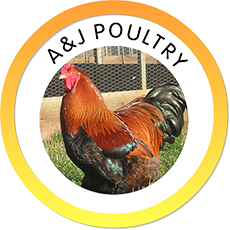The Sussex chicken is a dual purpose breed of chicken that originated in England around the time of the Roman conquest of Britain in AD 43. They come in eight colours (with a couple more being developed) and have a bantam version at 1/4 size; the bantams may be any of the eight colours.
There was a Sussex breed club formed back in 1903.
Appearance
Chickens are all different. They come in all colours but some coloured Sussex chickens are hard to get.

The colours found in Sussex chickens are: Brown, Buff, Light, Red, Speckled, Silver, White and Coronation. The Sussex chicken, whatever colour, should be graceful with a long, broad, flat back and a rectangular build, the tail should be at a 45 degree angle from the body. The eyes should be red in the darker varieties but orange in the lighter one and they sport a medium sized, single, erect comb. The earlobes are red and the legs and skin white in every variety. Cocks should weigh approximately 4.1 kg and hens about 3.2 kg. The Brown and red varieties are rare but the others are more common.

Light and Buff
The light Sussex has a white body with a black tail and black wing tips. Its neck is white, striped with black and has a very striking appearance. The feathers around the neck are called hackle feathers and each one is black with a fine white lace around the edge.
The buff is Ginger where the light is white. If showing the bird, a person must be careful to keep it out of strong sunlight, as the colour will fade.
Red
The Red Sussex is a brownish red plumage all over, with brighter colouring on the hackles and on the saddle feathers of the cock. The tail is black and laced with red.

Characteristics
The Sussex chicken is an alert, docile breed that can adapt to any surroundings. They are comfortable in both free range or confined spaces and in the presence of humans, although they will mate and breed better in larger spaces. The breed frequently goes broody in the warmer months. They are good foragers and are generally vigorous and hardy as a garden fowl.
Utility Aspects
Eggs
The Sussex was bred to be a dual purpose bird and is one of the most productive breeds of poultry. They lay large eggs that are cream to light brown in colour. A person owning a hen of this breed should expect approximately 240 to 260 eggs a year (from 180 to 320 eggs), although the light and white varieties are the best choice for layers. Recently there has been an olive green coloured egg introduced to some Light Sussex breeds, although these green egg layers are very rare. In some cases, exhibition lines that have been selected for exhibition qualities rather than egg laying over many generations may produce lower eggs numbers, although there are plenty of good laying lines still available.
Meat
It is a good producer of meat and all of the varieties are a good choice to have for this purpose. The chicks mature quickly for heavy breed but the speckled is slowest to mature. The carcass is a larger leggier shape than the commercial broiler chicken, but is closer to the heritage meat produced in the past. Cockerels that are harvested at around six months of age will be meaty with a firmer flesh than the younger broiler chicken of today.
History
Sussex chickens are believed to have been first bred in Britain (in the area that was to become England) around the time of the Roman invasion of AD 43 making them one of the oldest known breeds. Originally bred as a table bird the Sussex has since become a dual-purpose bird, working for both meat and egg production.[2] The original colours were the Brown, Red and Speckled, and the Silver is the latest variety. The breed was prized as table fowl more than one hundred years ago and, more recently, the Light Sussex was very popular for the laying trials of the 30s.
Today they are a popular breed for show exhibitions as well as a garden breed. The breed has made a huge contribution to the poultry industry and is even an ancestor to the modern broiler. The Coronation Sussex was bred to celebrate the coronation of King George, but is now an extremely rare breed. In Australia, the Coronation Sussex is becoming more popular as is the lavender Columbian.


